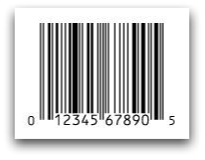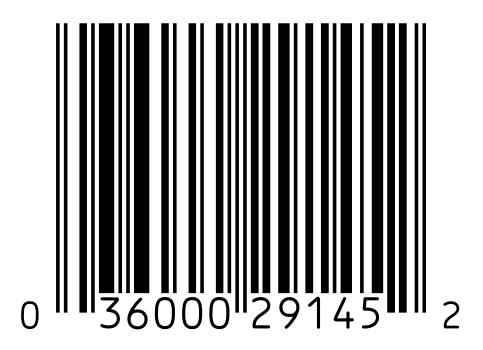1D (Linear) Barcodes | 2D Symbologies | Postal Codes
1D (Linear) Bar Code Symbologies
| Bar Code | Image | Characters | Format | Common Applications |
|---|---|---|---|---|
| Code 39 |
 |
128 Alphanumeric |
wide/narrow, |
Package Tracking, Manifests, Bills of Lading, Automotive Inventory, Vehicle ID, US DOD, Health Industry Bar Code Council (HIBCC) |
|
The first alpha-numeric symbology that originally encoded 39 characters (now 43) including uppercase letters (A - Z), digits (0 - 9) and a few special characters like the $ sign. The entire ASCII character set can be encoded using Code 39’s Full ASCII mode. The bar code does not contain a check digit but is considered self-checking because a single erroneously decoded bar can not generate another valid character. The code has very low data density compared to other 1D codes which does not make it feasible for small space applications. The name Code 39 is derived from the fact that three of the nine elements that constitute a codeword are wide elements, the remaining six are narrow. Code 39 was developed by Dr. David Allais and Ray Stevens of Intermec in 1974. It was later standardised as ANSI MH 10.8 M-1983 and MIL-STD-1189. |
||||
| Code 128 |
 |
128 Alphanumeric |
multiwidth, |
Lotteries, Package Tracking, Manifests, Bills of Lading, Patient Bracelets, Medication, Retail, POS, Returned Goods, Inventory Control |
|
Code 128 is a very high-density barcode symbology, used extensively world wide in shipping and packaging industries. GS1-128 (formerly known as UCC/EAN-128) is one of its variants. It is used for alphanumeric or numeric-only barcodes. It can encode all 128 characters of ASCII and is also capable of encoding two numbers into one character width, called double density. This feature is evidence of it being designed to reduce the amount of space the bar code occupies, to address the ever-increasing needs of item catalogs. Each printed character can have one of three different meanings, depending on which of three different character sets are employed. Code 128 is the major component of the labeling standard for GS1-128 (formerly known as UCC/EAN-128), used as product identification for container and pallet levels of retail markets.
|
||||
| Codabar |
 |
20 Numeric + punctuation |
wide/narrow, |
Libraries, Blood banks, Airbills, Patient Bracelets, Medication |
| Codabar was designed to be accurately read even when printed on dot-matrix printers for multi-part forms such as FedEx airbills and blood bank forms, where variants are still in use as of 2007. Although newer symbologies hold more information in a smaller space, Codabar has a large installed base in libraries. It is even possible to print Codabar codes using typewriter-like impact printers, which allows to create a large number of codes with subsequent numbers without having to use any digital equipment. After each printed code, the printer's stamp is mechanically turned to the next number, as for example in mechanical mile counters. | ||||
| EAN / JAN / UPC |
 |
10 Numeric |
multiwidth, |
Postal, Retail, POS, Returned Goods, Inventory Control |
| A European Article Number (EAN) is a bar coding standard which is a superset of the original 12-digit Universal Product Code (UPC) system developed in North America. The EAN-13 barcode is defined by the standards organization GS1. It is also called a Japanese Article Number (JAN) in Japan. UPC, EAN, and JAN numbers are collectively called Global Trade Item Numbers (GTIN), though they can be expressed in different kinds of bar codes. EAN-13 is a superset of UPC-A which means that any reader capable of decoding EAN-13 codes will also be able to decode UPC-A codes. EAN-8 is a 2- or 3-digit number system code followed by a 4- or 5-digit product code. The EAN-8 product codes are assigned directly by the numbering authority. This has the advantage that any company can request an EAN-8 code regardless of its EAN-13 manufacturer or product code. UPC-E is a shorter form of a UPC-A referred to as the zero suppression version. It allows customer codes with a larger numbers of zeros to be represented in a more compact version. | ||||
|
Interleaved 2 of 5 |
|
10 Numeric |
wide/narrow, |
Retail, POS, Returned Goods, Inventory Control |
| Interleaved 2 of 5 (I 2 of 5, I2/5) is a continuous two-width barcode symbology encoding digits. It is used on cartons of products, while the products inside are labeled with UPC or EAN. The symbology is called "interleaved" because the first numeric data is encoded in the first 5 bars while the second numeric data is encoded in the first 5 spaces that separate the first 5 bars. Thus the first 5 bars and spaces actually encode two characters. This is also why the bar code can only encode an even number of data elements. | ||||
| UPC |
 |
10 Numeric |
multiwidth |
Product Packaging |
| There are two main types of UPC codes - UPC-A and UPC-E. UPC-A is by far the most common and well-known bar code symbology. An UPC-A bar code is the bar code you will find on virtually every consumer good on the shelves of your local supermarket, as well as books, magazines, and newspapers. It is commonly called simply a "UPC bar code" or "UPC Symbol." UPC-A encodes 11 digits of numeric (0 through 9) message data along with a trailing check digit, for a total of 12 digits of bar code data. Each UPC-A code contains four sections - Number System, Manufacturer Code, Product Code and Check-Digit. UPC-E is a variation of UPC-A which allows for a more compact bar code by eliminating extra zeros to create an 8 digit code from a 12 digit UPC-A. | ||||
2D Symbologies
| Bar Code | Image | Characters | Format | Common Applications |
|---|---|---|---|---|
| Data Matrix |
 |
Alphanumeric | 28.5% - 62.5% error correction | Manufacturing part tracking, lotteries, ID cards, registrations, asset tracking, medication, patient bracelets, etc. |
|
A Data Matrix code is a two-dimensional matrix barcode consisting of black and white square modules arranged in either a square or rectangular pattern. The information to be encoded can be text or raw data. Usual data size is from a few bytes up to 2 kilobytes. The length of the encoded data depends on the symbol dimension used. Error correction codes are added to increase symbol strength: even if they are partially damaged, they can still be read. A Data Matrix symbol can store up to 2,335 alphanumeric characters.
The most popular application for Data Matrix is marking small items, due to the code’s ability to encode fifty characters in a symbol that is readable at 2 or 3 mm2 and the fact that the code can be read with only a 20% contrast ratio. The Electronic Industries Alliance (EIA) recommends using Data Matrix for labeling small electronic components. Data Matrix codes are part of a new traceability drive in many industries, particularly aerospace where quality control is tight and a black market exists for counterfeit or non-servicable parts. Data Matrix codes (and accompanying alpha-numeric data) identify details of the component, including manufacturer ID, part number and a unique serial number. The United States Department of Defense aims to have all components of every new aircraft identified by Data Matrix codes within a tight deadline |
||||
| PDF417 |
 |
2710 characters | error correction | Manufacturing part tracking, Postal, Lotteries, Package Tracking, Manifests, Bills of Lading, ID Cards, Registrations, Asset Tracking, Patient Bracelets, Medication, Tradeshow Lead Tracking, Automotive Inventory, Vehicle ID |
| PDF417 is a 2-dimensional stacked bar code created by Symbol Technologies in 1991. PDF stands for Portable Data File and 417 represents the 17 modules of 4 bars and spaces that make up each code. Each symbol also has start and stop bar groups that allow the code to be easily identified. It is one of the most popular 2D codes because of its ability to be read with slightly modified handheld laser or linear CCD scanners. PDF417 is used in a variety of applications, including transport, identification cards, and inventory management. It is best suited for uses where information needs to move with an item or document. | ||||
| QR Code |
 |
7,089 Num 4,296 Alpha 2,953 Bytes |
error correction | Automotive Inventory, Vehicle ID, URLs for Mobile Phones |
| A QR Code is a 2D matrix code created by the Japanese corporation Denso-Wave in 1994. The "QR" is derived from "Quick Response", as the creator intended the code to allow its contents to be decoded at high speed. QR Codes are currently the most popular type of two dimensional code in Japan. Although initially used for tracking parts in vehicle manufacturing, QR Codes are now used in a much broader context spanning both commercial tracking applications as well as convenience-oriented applications aimed at mobile phone users. QR Codes storing addresses and URLs may appear in magazines, on signs, buses, business cards or just about any object that a user might need information about. A user having a camera phone equipped with the correct reader software can scan the image of the QR Code causing the phones browser to launch and redirect to the programmed URL. | ||||
Postal Bar Code Symbologies
| Bar Code | Image | Characters | Format | Common Applications |
|---|---|---|---|---|
| Intelligent Mail |
 |
31 Numeric 4-State |
CRC frame check sequence | (USPS) Postal sortation, auditing, certified mail, registered mail, metered mail, POS, etc. |
| (aka USPS 4CB, OneCode Solution Barcode, OneCode ACS) The Intelligent Mail® barcode (formally known as the 4-State Customer Barcode) is the next generation of USPS® bar code technology used to sort and track letters and flats. The 31-digit Intelligent Mail barcode (65 bars) is slightly longer than the 11-digit POSTNET barcode (62 bars), and it offers mailers certain flexibility in choosing the height and width of the bar code. | ||||
| POSTNET |
 |
5 - 11 Numeric 2-State |
checksum error detection | (USPS) Postal sortation, auditing, certified mail, registered mail, metered mail, POS, etc. |
| POSTNET is a barcode symbology that is used by the United States Postal Service to assist in directing mail. The ZIP Code or ZIP+4 code is encoded in this unique symbology that encodes data in half- and full-height bars. Most often, the delivery point is added, usually being the last two digits of the address or PO box number. | ||||


